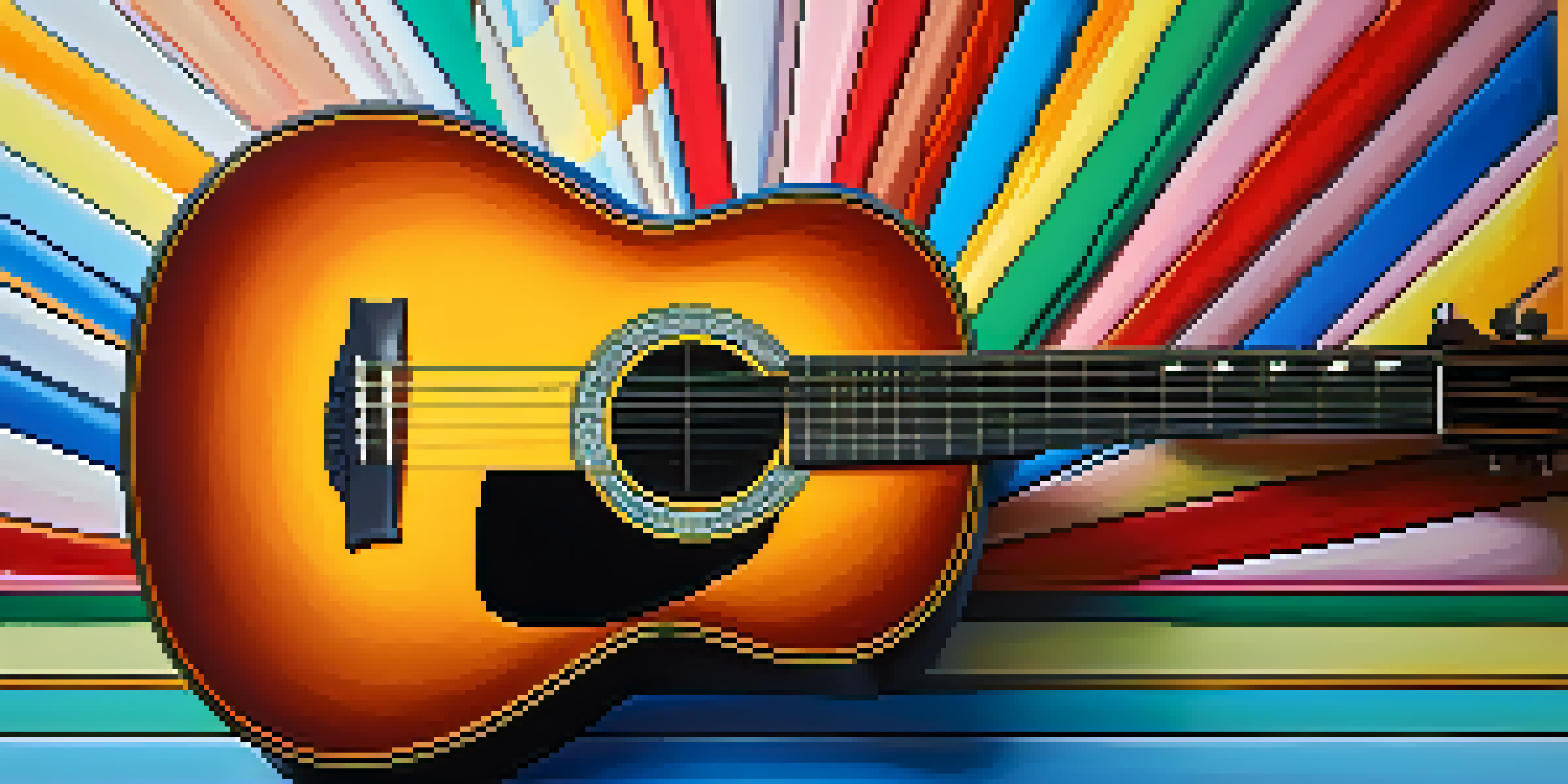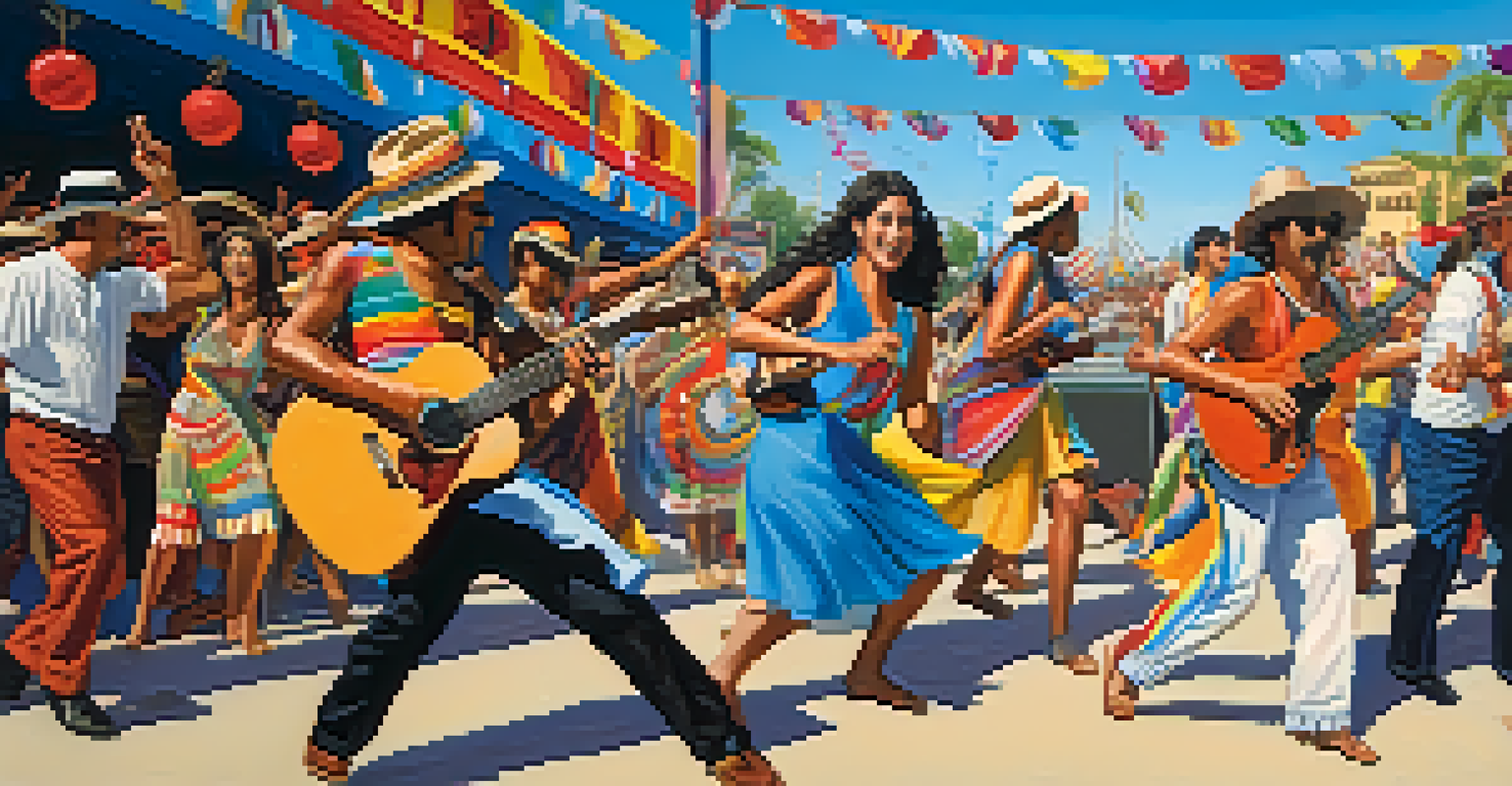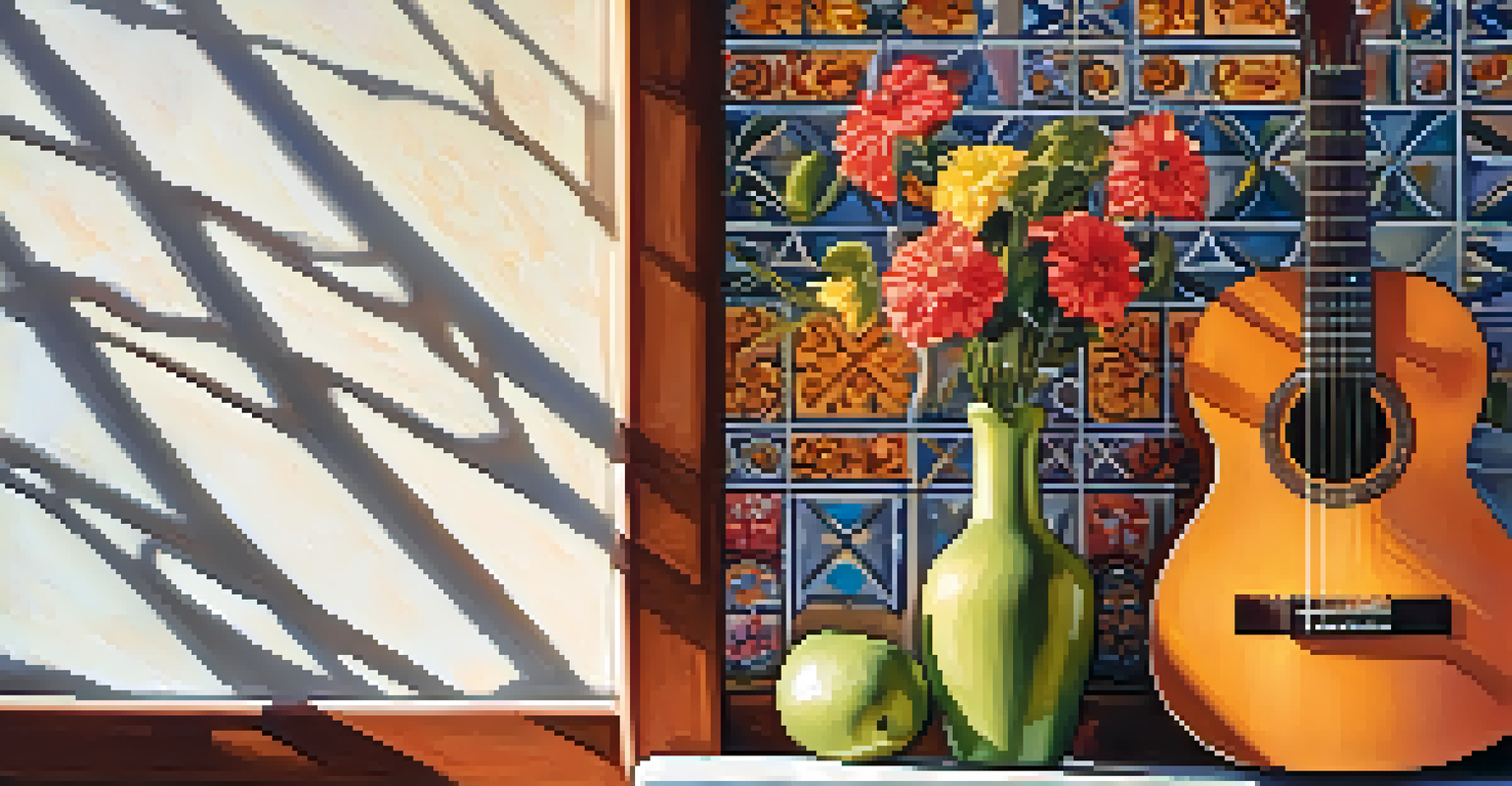The Role of Guitar in Latin Music and Its Vibrant Rhythms

The Heartbeat of Latin Music: The Guitar's Significance
The guitar serves as a fundamental instrument in Latin music, providing both rhythm and melody. Its versatility allows it to adapt to various styles, from flamenco to samba, making it a key player in the genre. In many Latin cultures, the guitar isn’t just an instrument; it's a symbol of tradition and community.
The guitar is a miniature orchestra in itself.
When you listen to Latin music, you often hear the guitar driving the beat, creating a lively atmosphere. It connects musicians and audiences alike, fostering a shared experience that transcends language barriers. The strumming and plucking of the strings evoke emotions that resonate deeply within the hearts of listeners.
Moreover, its role extends beyond performance; the guitar is often used in songwriting and composition. Many famous Latin artists leverage its rich sound to craft memorable melodies that linger long after the song ends. This connection between the guitar and songwriting showcases its importance in the music-making process.
Diverse Styles: The Guitar's Adaptability in Latin Music
Latin music is a tapestry of diverse styles, and the guitar adapts beautifully to each one. From the intricate fingerpicking of classical guitar in Spanish flamenco to the rhythmic strumming found in Brazilian bossa nova, the instrument is incredibly versatile. This adaptability allows musicians to explore various sounds and influences.

For instance, the guitar is integral to mariachi music, where it provides both rhythm and harmony. The lively strumming complements the vibrant trumpets and violins, creating a festive soundscape that invites celebration. This example highlights how the guitar can blend seamlessly with other instruments to enhance the overall musical experience.
Guitar: Heart of Latin Music
The guitar serves as a fundamental instrument in Latin music, symbolizing tradition and community while driving rhythm and melody.
In contrast, the guitar also plays a crucial role in genres like salsa, where it adds to the danceable groove. The syncopated rhythms and melodic lines create an infectious energy that gets everyone on their feet. This versatility is a testament to the guitar's ability to adapt to the diverse cultural influences within Latin music.
The Rhythmic Foundation: Guitar Techniques in Latin Music
One of the most captivating aspects of Latin music is its complex rhythms, many of which are anchored by the guitar. Techniques like strumming patterns, fingerpicking, and percussive slaps contribute to a rich, textured sound. These techniques not only define the genre but also invite musicians to experiment and innovate.
Music is the universal language of mankind.
For example, the use of syncopation—a rhythmic concept where emphasis is placed on unexpected beats—creates a lively and unpredictable feel. Guitarists often employ this technique to keep listeners engaged, adding an element of surprise to their performance. This rhythmic playfulness is key to the infectious energy that characterizes Latin music.
Additionally, the guitar's ability to create multiple sounds—from melodic lines to rhythmic grooves—allows it to serve as both a lead and accompanying instrument. This dual role enhances the overall musicality, making the guitar an indispensable tool for musicians. Its rhythmic foundation is a driving force that shapes the very essence of Latin music.
Cultural Influences: The Guitar's Global Journey in Latin Music
The guitar's journey through Latin music is a reflection of the cultural exchanges that shape the genre. Originating from various parts of the world, the guitar has been embraced and adapted by different Latin American cultures. As a result, it carries a rich history that tells the story of migration and musical fusion.
For instance, Spanish guitar techniques influenced the development of Latin styles in countries like Argentina and Cuba. The incorporation of indigenous rhythms and African elements further enriched the guitar's role in these regions. This blending of cultures showcases the guitar's ability to transcend boundaries and unite diverse musical traditions.
Diverse Styles Showcase Guitar's Versatility
From mariachi to salsa, the guitar adapts beautifully to various Latin music styles, enhancing the overall musical experience.
Today, the guitar continues to evolve, incorporating modern influences and technology. Artists are experimenting with electric guitars and digital effects, pushing the limits of what this instrument can do. This ongoing evolution highlights the guitar's dynamic nature and its lasting impact on Latin music.
The Emotional Connection: Guitar as a Storyteller in Latin Music
Beyond its technical aspects, the guitar serves as a powerful storyteller in Latin music. Each strum and pluck can evoke a range of emotions, from joy to melancholy. This emotional expressiveness allows artists to connect with their audience on a deeper level, making each performance memorable.
For example, in bolero music, the guitar often plays a pivotal role in conveying romantic themes. The slow, heartfelt melodies resonate with listeners, drawing them into the narrative of love and longing. This ability to tell stories through music is a hallmark of Latin culture, and the guitar is central to this tradition.
Moreover, the guitar's role as a storyteller extends to live performances, where improvisation adds an element of spontaneity. Musicians often interact with their audience, creating an intimate atmosphere where shared experiences unfold. This emotional connection is what makes Latin music so captivating, and the guitar is at the heart of it all.
Iconic Guitarists Shaping the Latin Music Landscape
Throughout history, numerous iconic guitarists have made significant contributions to Latin music, each adding their unique flair. Artists like Paco de Lucía revolutionized flamenco guitar, blending traditional techniques with contemporary influences. His innovative style has inspired countless musicians and elevated the genre to new heights.
Another notable figure is Carlos Santana, whose fusion of rock and Latin music has left an indelible mark on the music industry. By incorporating the guitar into his signature sound, he has introduced Latin rhythms to a global audience. This cross-genre exploration showcases the guitar's versatility and its ability to connect with diverse musical styles.
Guitarists Shape Latin Music's Future
Iconic guitarists like Paco de Lucía and Carlos Santana have redefined the genre, inspiring new generations and blending tradition with innovation.
These guitarists, among many others, exemplify the rich tapestry of talent in Latin music. Their contributions not only celebrate the guitar but also inspire future generations of musicians. As they continue to push boundaries, the guitar remains a vital instrument in the evolution of Latin music.
The Future of Guitar in Latin Music: Innovation and Tradition
Looking ahead, the guitar's role in Latin music is poised for exciting developments. As new generations of musicians emerge, they are blending traditional techniques with modern innovations. This fusion not only keeps the genre fresh but also honors the rich heritage of Latin music.
Technology also plays a significant role in shaping the future of the guitar in Latin music. With the rise of digital platforms, artists can reach a global audience, sharing their unique interpretations and styles. This accessibility allows for greater experimentation and collaboration, leading to a vibrant musical landscape.

Ultimately, the future of the guitar in Latin music lies in its ability to adapt and evolve. As musicians continue to explore new sounds and influences, the guitar will remain a central figure in this dynamic genre. Its enduring presence is a testament to its significance in the world of music.